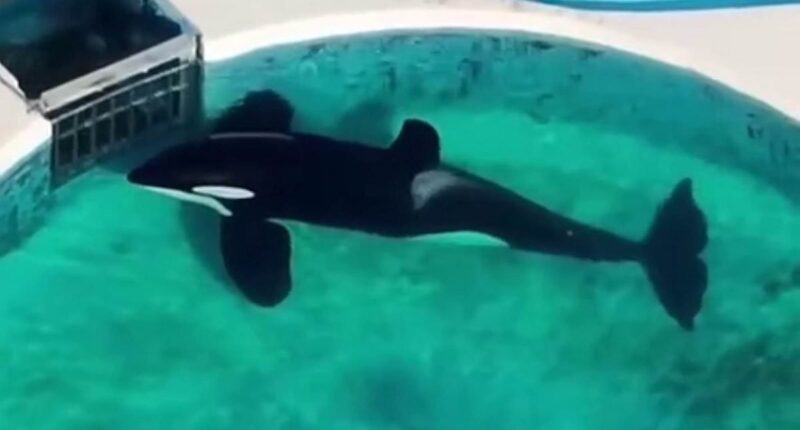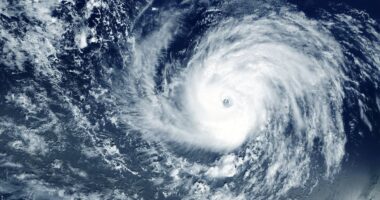They swim in dizzying circles, they go blind and they die slowly.
This is the miserable existence endured by many of the sea creatures kept in captivity.
Some of the most disturbing cases of animal abuse in living memory have unfolded at marine parks.
Behind smiling trainers posing for photos and animals performing tricks for cheering crowds, creatures are suffering in silence.
Animal rights activists have spent years trying to end the torment – but the horror stories keep emerging.
Several recent disturbing cases of negligence have come to light, such as dolphins losing their vision due to chlorine exposure, a distressed whale continuously hitting its tank, and a manatee deteriorating from the effects of isolation.
The public is now starting to understand the inhumanity lurking behind these artificial shows, leading to increasing pressure on those who continue to profit from confining these animals in such conditions.
Heartbreaking story of Lolita
Lolita, the ‘loneliest whale in the world’, spent more than 50 years in captivity before she died, aged 57, in 2023.
For a considerable period, experts have been raising objections to the inadequate living environment provided for marine mammals at the Miami Seaquarium, particularly criticizing the small 80-foot long and 35-foot wide pool where the animals are kept.
Lolita’s body was roughly the same length as the tank itself, making it impossible for her to fully submerge.
Heartbreaking video footage showed the creature floating aimlessly under the scorching sun.
Plans to return Lolita to the wild had been in place shortly before her death, but tragically, she passed away before she could be set free.
Lolita started exhibiting serious signs of discomfort days before she died. She received treatment but could not be saved.

Pictured: The ‘loneliest whale in the world’, Lolita, in 1970. Lolita died in 2023 after living in captivity for more than 50 years

Plans to return Lolita to the wild had been in place but she tragically passed away before she could be freed

Experts and concerned individuals had long protested against Lolita’s conditions in captivity, including the size of her 80-foot long and 35-foot wide tank at Miami Seaquarium. Pictured: Lolita pushes her trainer up into the air
Just 10 years after Lolita arrived at the aquarium, her companion Hugo died of an aneurysm that was caused by repeated head trauma, earning her the title of the world’s loneliest whale.
Washington’s Lummi Nation, a Native American tribe, traveled to Miami in 2018 to leave a nearly 4,000lb totem pole behind as part of an effort to bring the orca back to Washington. It was part of an $8.5million effort to bring Lolita home, according to CBC.
Jewell James, a member of the tribe, accused the Seaquarium of abandoning the animal’s needs for money by forcing her to perform for audiences a couple of times a day and said keeping her in the 20-foot tank was like keeping her in a prison cell.
‘She’s our relative and we want her back,’ he said.
Lolita was the oldest whale in captivity and performed until 2022 when she was finally retired after falling ill.
In a statement made following Lolita’s death Miami Seaquarium described her as ‘an inspiration to all who had the fortune to hear her story’.
‘At her advanced age, her passing is not a complete surprise,’ the facility added.
‘Yet it is a tremendous and overwhelming loss, one felt particularly by those who have loved and cared for her on a daily basis, as well as those around the world that care so much for her.’
Dolphin smashes into concrete during display
The horrifying moment a dolphin died after leaping out of a pool at a Mexican resort and smashing down into the concrete floor was caught on camera in January.
Footage filmed by a tourist shows a group of dolphins jumping out of the water in sync during a show at the Barcelo Riviera Maya hotel in Mexico.
But one of them can be seen missing the mark and hitting a narrow sliver of concrete separating the big pool from a smaller one as the crowd gasped in shock.
The dolphin appeared lifeless as it lied by the side of the pool, with a trainer rushing over to check on the marine mammal.
Some of the other dolphins then emerged from the water, appearing to check on their pod mate.

The horrifying moment a dolphin died after leaping out of a pool at a Mexican resort and smashing down into the concrete floor was caught on camera in January

Footage filmed by a tourist shows a group of dolphins jumping out of the water in sync during a show at the Barcelo Riviera Maya hotel in Mexico. But one of them can be seen missing the mark and hitting a narrow sliver of concrete separating the big pool from a smaller one
The dolphin’s horrifying death has caused outrage, with animal rights organisations including Animal Heroes, Dolphin Freedom, Marea and Oceanos De Vida Libre announcing its death in a joint statement.
‘For a year now, the organisations Animal Heroes, Dolphin Freedom, Marea, and Oceanos De Vida Libre have maintained a permanent campaign demanding the closure of this dolphinarium, which is one of the smallest in Mexico,’ they said.
Hotel Barceló closed earlier this month after a series of videos exposed the appalling treatment of dolphins there.
Phil Demers, director of UrgentSeas, said the mammals were being imprisoned in small, dirty pools.
Footage captured by the non-profit organisation, which works to expose cruel captive dolphin and whale facilities, shows two dolphins swimming aimlessly round the subpar facilities.

The dolphin appeared lifeless as it lied by the side of the pool, with a trainer rushing over to check on the marine mammal
The concrete pool where the animals live is located mere feet from the Caribbean Sea and is just over six feet deep, leaving the dolphins exposed to constant sunlight — which experts say can burn their skin.
UrgentSeas say they were first contacted about the horrific conditions at Dolphinaris Barcelo, in Quintana Roo, months ago, but that authorities failed to take action.
The park was only shut down after the organisation’s videos of the dolphins sparked public outrage, according to Demers.
‘We were first alerted about the conditions months ago as we learned that authorities were allowing for repeated violations to continue at the park,’ the 47-year-old said.
‘Once we saw the conditions for ourselves, we knew we had to make some noise to expose the issues.
‘The conditions were unacceptable – so much so that we felt compelled to act.
‘We started publishing videos, which went immediately viral, causing a major public outrage. The reaction was powerful.
‘Their social media accounts were inundated with negative reviews and comments, and authorities were called to take actual action.
‘Authorities were finally forced to shut down the awful tank, which had been our long goal.
‘We are ecstatic that authorities have taken this action.’
Distressed whale bashes head against wall
A ‘distressed’ killer whale caged at a water park in Canada was filmed smashing her head against the side of her tank in after spending a decade in isolation in 2021.
Kiska was seen violently headbutting the glass at MarineLand, Niagara Falls, in the heartbreaking 30-second clip.
Activists were outraged by the footage and campaigned to release Kiska – but their efforts were unsuccessful and she died in 2023 aged 47.
According to iNews, Rob Lott, end captivity campaigner at the Whale and Dolphin Conservation, said Kiska’s behaviour in the video ‘is a direct, stress-related result of wild-caught Icelandic orca, Kiska being raised in an artificial, concrete environment for the last four decades’.

A ‘distressed’ killer whale caged at a water park in Canada was filmed smashing her head against the side of her tank in after spending a decade in isolation. Kiska was seen violently headbutting the glass at MarineLand, Niagara Falls, in the heartbreaking 30-second clip which was filmed in 2021

Activists were outraged by the footage and campaigned to release Kiska – but their efforts were unsucesful and she died in 2023 aged 47
‘Sadly, this isn’t unique and the repetitive, self-inflicted behaviour shown by Kiska has been seen in other captive orcas where years of boredom in barren, featureless tanks with little or no stimulation manifests itself this way,’ he said.
The cause of death for the whale was not released, but MarineLand said in a statement that her health had been declining for weeks.
The theme park said: ‘MarineLand’s marine mammal care team and experts did everything possible to support Kiska’s comfort and will mourn her loss.’
At three years of age, Kiska was taken from her family near Iceland, along with an orca named Keiko, who later starred in the 1993 film Free Willy.
She was taken to an aquarium in Iceland, where she stayed with four other young orcas, including Keiko.
Shortly afterwards, Kiska was sold, along with Keiko, to MarineLand, according to animal activist Phil Demers, who previously worked at the park.
Keiko was then sold on to an entertainment park in Mexico but would later be rescued, rehabilitated and returned to the sea near Iceland.

Pictured: Kiska is seen through the underwater viewing area in Friendship Cove Friday July 20, 2012

Pictured: Kiska is shown being fed in Friendship Cove at MarineLand
Keiko died of pneumonia in 2003 in a bay in Norway at the age of 27.
At MarineLand Kiska gave birth to five calves – Athena, Hudson, Nova, Kanuck, and one who did not live long enough to be named. All of the calves died at a young age.
Kiska was the last captive orca in Canada and the focus of several animal activist protests at MarineLand.
Animal rights group People for the Ethical Treatment of Animals (PETA) described Kiska as the ‘world’s loneliest orca’ whose life was affected by ‘tragedy after tragedy’ after the death of her calves.
The Whale Sanctuary Project said: ‘Studies suggest that orcas’ capacity to feel deep, complex emotions rivals or even exceeds the emotional capacity possessed by humans.
‘The bond between mother and calf is so deep that it is hard to imagine the grief and trauma of each of Kiska’s losses over the years.’
Cruel trainer caught straddling dolphin
A trainer at Dubai Dolphinarium was investigated for alleged animal abuse after video emerged of her sitting on the back of one of the animals.
The footage, captured at the UAE tourist attraction in 2019, shows the female trainer sitting on a dolphin’s back for around six seconds before it dives into a pool.
Experts said the stunt could easily have damaged the dolphin’s organs because the mammals cannot support their own body weight outside of water, so adding the weight of a human on top of that risks causing serious harm.
Campaigners identified two trainers who they said were responsible for the video, both of whom deleted their accounts after the incident.

A trainer at Dubai Dolphinarium was investigated for alleged animal abuse in 2019 after video emerged of her sitting on the back of one of the animals

The footage, captured at the UAE tourist attraction in 2019, shows the female trainer sitting on a dolphin’s back for around six seconds before it dives into a pool
A spokesman for the Dolphinarium, which opened in 2008, confirmed at the time that an investigation was underway but refused to discuss it further.
Dr Elsayed Mohammad, Regional Director of the International Fund for Animal Welfare, told Gulf News: ‘It is well known that the body of dolphins is very sensitive.
‘The dolphin’s body is not adaptable to any pressure outside water. Pressing the abdomen of the dolphin to the floor can easily harm its internal organs.
‘If you punch the abdomen of a person, you can imagine how painful it is.
‘Regardless of whether it’s a few seconds or not, it’s wrong. It is animal cruelty.’
The Dubai Dolphinarium is a popular tourist attraction which offers people the chance to watch dolphins and seals perform circus-style tricks in daily shows.
The 45-minute performances include the animals dancing, singing, juggling, playing ball, and jumping through hoops.
Guests can also pay extra for a ‘swim with dolphins’ experience, which involves being hauled along while clinging to the animal’s belly fins or dorsal fin.
World’s saddest orca
Heartbreaking footage taken in 2024 showed a captive killer whale laying almost motionless whilst staring at the gate to his enclosure for 24 hours straight.
Kshamenk, a 35-year-old Orca, is being held in a tiny pool at Mundo Marino, Argentina’s largest aquarium.
Shocked visitors have accused the park of holding the killer whale in cramped conditions with restricted movement and in total isolation from its own species.
A 24-hour timelapse filmed by campaign group UrgentSeas shows Kshamenk languishing motionless with his face pointed directly towards the enclosure’s gate as if asking to be let out.
Kshamenk – previously described as ‘the world’s loneliest Orca’ – was first brought to Mundo Marino in 1992 after being captured off the Samborombón Bay on the coast of Buenos Aires.

Heartbreaking footage taken in 2024 showed a captive killer whale laying almost motionless whilst staring the gate to his enclosure for 24 hours straight in Argentina. Pictured: A screen grab from the video shot by UrgentSeas that they then posted on social media

Kshamenk, a 35-year-old Orca, is being held in a tiny pool at Mundo Marino, Argentina’s largest aquarium
According to the aquarium, the then three-year-old orca was found beached on the bay by three fishermen along with three other killer whales.
Kshamenk was then taken to his concrete tank at the aquarium, where he has spent the last 32 years.
His tankmate Belen died in 2000, at the age of 13, meaning that he has reportedly spent the last 24 years in total isolation from his own species.
UrgentSeas, a non-profit organisation advocating to end marine captivity, is campaigning to free Kshamenk and bring him to an open sanctuary with other orcas to socialise with.
He is now the last remaining captive killer whale in Argentina.
A spokesperson from the organisation said: ‘We continue to work with Argentinian activists and members of Congress to try to highlight and address his cruel world.
‘He needs to be removed from his tiny concrete tank and to join other members of his species before it’s too late.’
Petitions calling for Kshamenk to be released to the wild have garnered tens of thousands of signatures.
But, in a statement sent to ABC News, Mundo Marino said this is ‘impossible’.
The statement read: ‘We are aware of what some activist groups believe about a hypothetical reintroduction; we respect their position, but the reality is that this is a proposal without a consistent scientific basis.
‘It is impossible for Kshamenk to return to the sea without putting his life at serious risk.’
Manatee kept in solitary confinement
Drone footage exposed how a 69-year-old manatee named Romeo had been left to live out his twilight years alone in tiny 30ft concrete pool.
The heartbreaking video, taken in 2023, shows the gentle creature using one flipper to swim in dizzying circles in his isolated, murky cage at Miami Seaquarium.
Manatees are semi-social animals and ‘suffer psychologically when not living in pairs or groups’ – but Romeo had been alone for years after being separated from his partner, and the mother of his offspring, Juliet.
But, although it’s rare for stories of animals kept in captivity to have positive outcomes, Romeo was one of the lucky ones.

In 2023 drone footage exposed how a 69-year-old manatee named Romeo had been left to live out his twilight years alone in tiny 30ft concrete pool

Manatees are semi-social animals and ‘suffer psychologically when not living in pairs or groups’ – but Romeo had been alone for years after being separated from his partner, and the mother of his offspring, Juliet

Pictured: A cover over Romeo’s murky pool at Miami Seaquarium
The clip went viral and led to more than 20,000 people signing a petition putting pressure on the Florida aquarium to release him.
And, in December 2023, their wishes were granted and the gentle giant was finally freed from his miserable prison.
The Manatee Rescue & Rehabilitation Partnership (MRP) successfully transported three manatees – Romeo, Juliet and Clarity – from Miami Seaquarium (MSQ) to SeaWorld Orlando and ZooTampa.
The transportation was a tremendous struggle due to the animals’ size, weight and health condition.
But accompanied by specialized vehicles and an experienced team of vets and animal care specialists, all three made the trip safely.
In a report released earlier that month the USDA cited the Miami Seaquarium for alleged insufficient animal care and staffing problems – and lambasted them for their treatment of Romeo.
The report said that Romeo had been housed alone in his enclosure because the three other manatees he was living with were released back into the wild in the spring.

In a report released in 2023 the USDA cited the Miami Seaquarium for alleged insufficient animal care and staffing problems – and slammed them for their treatment of Romeo

The clip went viral and led to more than 20,000 people signing a petition putting pressure on the Florida aquarium to release him. And, in December 2023, their wishes were granted and the gentle giant was finally freed. Pictured: Romeo being transported
And despite numerous attempts to acquire another manatee the Seaquarium did not meet the requirements to do so.
The report noted: ‘Although numerous attempts have been made to acquire another manatee it was determined the facility did not yet meet the requirements to receive another animal.
‘Manatees are semi-social animals and do better medically and psychologically when they are housed in pairs or groups.’
Miami Seaquarium also housed the ‘loneliest whale in the world’, Lolita before she died.
The facility was ordered to close and vacate its premises on April 21, 2024.
Killer whales left to die
France’s last two captive killer whales are stranded in an abandoned algae-infested Marine park, neglected with the exception of a skeleton staff that comes in intermittently to feed them.
In a nearby smaller tank, 12 bottlenose dolphins are the only other occupants of the facility, who have been stuck in bleak living conditions since January.
The majestic creatures remain confined in Marineland Antibes, a French marine park near Cannes that shut its doors four months ago.

France’s last two captive killer whales are stranded in an abandoned algae-infested Marine park, neglected with the exception of a skeleton staff that comes in intermittently to feed them
Disturbing drone footage released by animal activist group TideBreakers shows the orcas Wikie, 23, and her 11-year-old son Keijo wandering aimlessly around the abandoned park.
The video also shows the algae-infested pool where the remaining dolphins are kept.
But despite their despairing condition, French authorities have yet to identify a suitable site in Europe for the orcas and have rejected a proposed move to a marine zoo in Japan.
Marketa Schusterova, co-founder of TideBreakers, said: ‘The situation in Marineland Antibes is an emergency and needs worldwide attention.
‘These are the last two remaining orcas in captivity in France and they should be moved quickly.
‘The orcas need to be removed from dangerous conditions that are posing significant risks to their health and safety.’
The marine park closed on January 5, citing legislation banning shows featuring cetaceans such as dolphins and whales, which the French government passed in 2021.

The majestic creatures remain confined in Marineland Antibes, a French marine park near Cannes that shut its doors four months ago
Since then, the management for Marineland have been shuffling through various options for where to rehome the animals, especially the orcas.
Though Marineland has closed as a marine zoo business, they are still legally responsible for the welfare of the animals until they are rehomed. The orcas were both born in captivity so could never survive in the wild.
Animals trapped in filthy tanks
Dolphins housed at Florida’s Gulf World Marine Park have finally been relocated after they were reportedly left to rot and swim in their own filth.
Activists demanded the animals be moved after five dolphins have died there in less than a year.
It comes after the facility’s company went bankrupt in March and could not afford to maintain it.
Campaigners believe the conditions were so bad that dolphins had started going blind after they were filmed swimming with their eyes ‘jammed shut’ in murky water.

Dolphins housed at Florida’s Gulf World Marine Park have finally been relocated after they were left to rot in filthy, cramped tanks

Campaigners believe the conditions were so bad that dolphins had started going blind after they were filmed swimming with their eyes ‘jammed shut’ in murky water
The rough-toothed were transported to Clearwater Marine Aquarium on June 4 and authorities have launched an investigation into their former home.
Despite activists voicing concerns over the well-being of the marine life at Gulf World the park remained open until May 30.
Until then dolphins were forced to perform tricks for crowds and endure human encounters with customers who pay £97 to swim in their enclosure.
A scathing report released earlier this year exposed the dire living conditions of the animals housed at the park.
It raised a litany of concerns such as dolphin holding tanks filled with algae, broken water filters, lack of shade, and deteriorating facilities.
The filter in one of the dolphins’ tanks stopped working last November, and the filter in the second tank only works at 50% capacity, meaning they have reportedly been swimming around in their own filth for six months.

Despite activists voicing concerns over the well-being of the marine life at Gulf World the park remained open until May 30
Meanwhile, green algae has started growing in the crumbling tanks and inspectors from the US Department of Agriculture scraped nearly six inches of the plant off the step of one of the pools.
The animals had been moved to a separate pool so staff could ‘shock’ the water with granular chlorine to treat the algae growth.
But the harsh chemical can cause blindness in dolphins after repeated exposure and and aerial footage from campaign group Tidebreakers suggested the poor water quality had started to cause health problems.
Five dolphins at Gulf Word have died in mysterious circumstances within six months including one in March that landed on its head in front of children in a shallow part of the pool.
Jett, who was 14 and had lived his entire life at Gulf World, dove head-first into the shallows during a show, causing a fatal brain injury.
Crying park staff had to escort families out of the arena so medics could treat the dying animal.
Experts later suggested Jett could have misjudged his jump due to the murkiness of the water, which has been the subject of concern for months.
Three more dolphins died within a week of each other last October.
Gus, 14, was euthanised for a life-threatening condition, 15-year-old Turk contracted a bacterial lung disease, and Nate, 20, died from systemic infection, according to the Marine Mammal Inventory Report.
The most recent fatality came just one week ago when a dolphin called Samira died.
The World’s loneliest dolphin
Honey, the ‘world’s loneliest dolphin’, died in 2020 after spending two years alone in a tiny tank at a derelict aquarium.
The creature – who had spent her life in captivity – was abandoned at the Inubosaki Marine Park Aquarium in Japan along with dozens of penguins in 2018.
Activists campaigned to free the animals but their efforts were unsuccessful and Honey never escaped her gloomy prison.
The operator of the park shut the facility following a decline in visitors after the 2011 earthquake and Fukushima nuclear crisis.

Honey, the ‘world’s loneliest dolphin’, died in 2020 after spending two years alone in a tiny tank at a derelict aquarium. The creature who had spent her life in captivity – was abandoned at the Inubosaki Marine Park Aquarium in Japan along with dozens of penguins in 2018
But, Honey and 46 penguins, along with hundreds of fish and reptiles, were left behind, an official with the Chiba Health and Welfare department said.
Photos and video taken by activists from outside the park at the time show Honey floating in a tiny pool in an eerily empty facility.
In another picture, dust-covered penguins can be seen perched on a crumbling structure near a pile of debris.
The female bottlenose dolphin was captured in 2005 near Taiji, a western port town that has become notorious for its annual dolphin hunt that was featured in the Oscar-winning 2009 documentary The Cove, Japanese media reports.
The Dolphin Project attempted to intervene, reaching out to rescue Honey and the other abandoned animals.
They even explored purchasing her from the new owners of the facility in an effort to offer Honey a peaceful retirement.
However, by March 2020, it became clear that her health had deteriorated beyond recovery and she passed away.

















